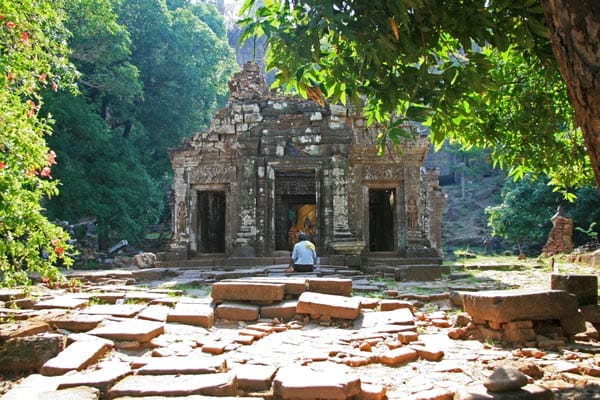One of the most evocative Khmer ruins outside Cambodia’s borders, Wat Phou, 8km southwest of Champasak, should be at the top of your southern Laos must-see list. It’s not hard to see why the lush river valley here, dominated by an imposing 1500m-tall mountain, has been considered prime real estate for nearly two thousand years by a variety of peoples, in particular the Khmer. The surrounding forests are rich with wildlife, including the rare Asiatic black bear. The pristine state of the environment – it is without question one of the most scenic landscapes chosen by the Khmer for any of their temples – was a major factor in UNESCO’s decision to name the area a World Heritage site.

Wat Phou (“Mountain Monastery” in Lao) is actually a series of ruined temples and shrines dating from the sixth to the twelfth centuries. Although the site is now associated with Theravada Buddhism, sandstone reliefs indicate that the ruins were once a Hindu place of worship. When viewed from the Mekong, it’s clear why the site was chosen. A phallic stone outcropping, easily seen among the range’s line of forested peaks, would have made the site especially auspicious to worshippers of Shiva, a Hindu god that is often symbolized by a phallus.
Archeologists tend to disagree on who the original founders of the site were and when it was first consecrated. The oldest parts of the ruins are thought to date back to the sixth century and were most likely built by the ancient Khmer, although some experts claim to see a connection to Champa. Whatever the case, the site is still considered highly sacred to the ethnic Lao who inhabit the region today, and is the focus of afestival in February, attracting thousands of Lao and Thai pilgrims annually.
THE SITE
At the entrance to the site, a small museum houses pieces of sculpture found among the ruins as well as some said to have belonged to Prince Boun Oum. The stone causeway leading up to the first set of ruins was once lined with low stone pillars, the tips of which were formed into a stylized lotus bud. On either side of the causeway there would have been reservoirs known in Khmer as baray. As ancient Khmer architecture is rich in symbols, it is surmised that these pools represented the oceans that surrounded the mythical Mount Meru, home of the gods of the Hindu pantheon.

Just beyond the causeway, on either side of the path, two megalithic structures of sandstone and laterite mirror each other. According to local lore, they are segregated palaces, one for men and the other for women. Archeologists are sceptical though, pointing out that stone was reserved for constructing places of worship, and, even if this hadn’t been the case, the vast interiors of both buildings were roofless and would have afforded little shelter. The structure on the right as you approach is the best preserved. Its carved relief of Shiva and his consort Uma riding the sacred bull Nandi is the best to be found on either building.
As the path begins to climb, you come upon jagged stairways of sandstone blocks. Plumeria (frangipani) trees line the way, giving welcome shade and littering the worn stones with delicate blooms known in Lao as dok champa, the national flower of Laos. At the foot of the second stairway is a shrine to the legendary founder of Wat Phou. The statue is much venerated and, during the annual pilgrimage, is bedecked with offerings of flowers, incense and candles. When and why this one statue has come to be venerated in such a fashion is unknown, and once again, local folklore and archeological record diverge.
Continuing up the stairs, you come upon the final set of ruins, surrounded by mammoth mango trees. This uppermost temple contains the finest examples of decorative stone lintels in Laos. Although much has been damaged or is missing, sketches done by Georges Traipont, a French surveyor who visited the temple complex in the waning years of the nineteenth century, show the temple to have changed little since then. On the exterior walls flanking the east entrance are the images of dvarapalas and devatas, or female divinities, in high relief. On the altar, inside the sanctuary, stand four Buddha images, looking like a congress of benevolent space aliens. Doorways on each side of them lead to an empty room with walls of brick; it is thought that these walls constitute the oldest structure on the site, dating back to the sixth century.
To the right of the temple is a Lao Buddha of comparatively modern vintage, and just behind the temple is a relief carved into a half-buried slab of stone, depicting the Hindu trinity – a multi-armed, multi-headed Shiva (standing) is flanked by Brahma (left) and Vishnu (right). Continuing up the hill behind the temple, you’ll come to a shallow cave, the floor of which is muddy from the constant drip of water that collects on its ceiling. This water is considered highly sacred, as it has trickled down from the peak of Lingaparvata. In former times, a system of stone pipes directed the run-off to the temple, where it bathed the enshrined Shivalinga. By tradition, this water was utilized in ceremonies for the coronation of Khmer kings and later the kings of Siam.
Even today, Lao pilgrims will dip their fingers into a cistern located in the cave and ritually anoint themselves, although this is something foreign visitors should respectfully avoid.
If you follow the base of the cliff in a northerly direction, a bit of sleuthing will lead you to the enigmatic crocodile stone, which may have been used as an altar for pre-Angkor-period human sacrifices, though there is no hard evidence that ritual sacrifice was a part of the ceremonies that took place here. Nearby is a pile of sandstone rubble that once formed a pavilion and is thought by archeologists to be one of the oldest structures on the site. A few metres away to the north is the elephant stone, a huge, moss-covered boulder carved with the face of an elephant. This carving is relatively recent, probably dating from the nineteenth century.






